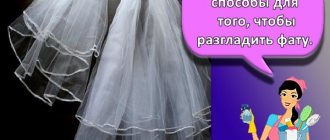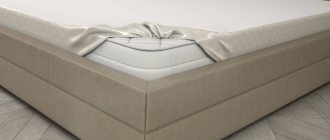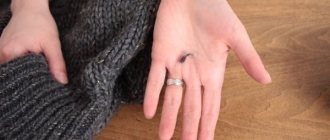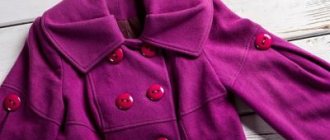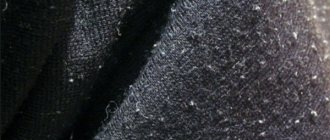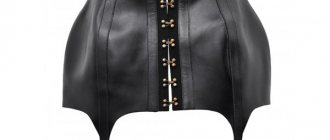What is it that clothes are not made from today? Made from acrylic, wool, elastane, cotton... You can't list everything. Each fabric requires special care. But it is simply impossible to remember all the details for each matter. In addition, it is not always possible to determine by eye what, for example, a jacket is filled with - padding polyester, down or holofiber. This makes it difficult to choose the right care. To prevent housewives from using trial and error, manufacturers have come up with special “care” badges. They are on the label. From the pictures you can get complete information on how to handle the textile product and what not to do. If you follow the recommendations, your clothes will remain presentable for an order of magnitude longer. And this is savings.
On coats and jackets, the tag can be found inside - on the side of the waist or in the inside pocket. In trousers they look for the tag on the back seam or on the side, and in shirts, dresses, T-shirts - under the collar at the back or on the side seam.
Basic character groups
Garment care icons are divided into five groups. Classification is carried out according to the action that can (or cannot) be carried out with the product. The group symbols and their meaning are presented in the table.
Table - Pictures to indicate groups, their meaning
| Drawing | Meaning |
| Basin with water | Washing rules |
| Square | Drying Features |
| Triangle | Is it possible to bleach |
| Circle | Professional cleaning (yes/no) |
| Iron | How to iron |
If the drawing is underlined, then the procedure for which it is “responsible” must be carried out carefully. Two lines below the image indicate that the product requires special delicate handling. Crossing out an icon indicates that the manipulation it represents cannot be done.
General recommendations
If there is no label, follow the general washing recommendations:
- Wash products made from synthetic materials separately from natural ones;
- separate items into white, colored and black and wash them separately;
- take into account the material of the product when choosing a program and washing mode;
- do not set high spin speeds;
- dry products in an automatic machine only in exceptional cases;
- Use bleach and dry cleaning with extreme caution and only as a last resort.
Before washing, be sure to sort dirty laundry, taking into account not only the color of the items, but also the composition of the fabric
If the label is missing or you cannot correctly decipher what the icons on the clothing mean, take into account the material of the product. Wash delicate fabrics (silk, viscose, velvet, etc.) by hand at a water temperature of +30 ℃.
Wool items can be washed by hand or in an automatic machine on a delicate cycle. For washing, use cool water and special detergents.
Cotton tolerates any type of care well, so you can safely wash it in a convenient way using classic powder. Synthetics do not tolerate high temperatures, so when cleaning, do not use hot water or a very hot iron.
To select the optimal washing mode, you can use special programs in the washing machine.
If there are no icons on the clothes, determine the type of fabric of the item and use special programs in the washing machine
Decoding the icons on clothes for washing
Labels on clothes for washing usually come first. They inform you whether the product can be washed, which wash is preferable, and what temperature conditions are suitable. Correctly deciphering the washing symbols on the label will help you care for the product as recommended by the manufacturer. If you wash an item as you please, without paying attention to the recommendations, it will quickly lose its presentation. Therefore, deciphering the signs for washing on clothes is so important, and the following table will help the housewife understand this issue.
Table - Symbols for washing and their meaning
| Symbol | Meaning |
| — A sign allowing both machine and hand washing; - rinsing and soaking is acceptable | |
| — A sign allowing only hand washing; — water temperature should not exceed 40°C; - you cannot rub the item intensively; - unscrew - with caution | |
| — A sign that says washing is prohibited; - Dry cleaning is acceptable | |
| — Any mode is acceptable, up to boiling at 95°C | |
| — The product must be washed and wrung out carefully; — recommended temperature — 30°C | |
| - Delicate wash; — recommended temperature — 30°C; - you can’t push up intensely |
Manufacturers use not only canonical, but also modified symbols on clothes for washing. For example, the temperature regime is often indicated not by numbers, but by dots. This can confuse the owner. In fact, such symbols on clothes for washing are easy to decipher. The number of dots corresponds to a certain temperature, all that remains is to remember which one. The table will help with this.
Table - Correspondence of points to temperature conditions
| Amount of points | Temperature, °C |
| 1 | 30 |
| 2 | 40 |
| 3 | 50 |
| 4 | 60 |
| 5 | 75 |
| 6 | 95 |
When you see the number 60, you don’t have to put the same number on the machine’s display. If the item is not very dirty and you were just planning to freshen it up, you can use the fast mode. The symbols on the laundry tag indicate the maximum temperature. Below is acceptable, but above is not.
How to connect to the clothing and textile labeling system
There are six steps to take.
Step 1. Purchase an enhanced qualified electronic signature certificate. If a company or entrepreneur already has a UKEP received for submitting reports or participating in government procurement, it is permissible to use it for labeling.
Get an electronic signature to work in mandatory marking systems Receive in an hour
Step 2. Go to the official portal of the “Honest Sign” and click the “Register” button.
Step 3. Select the product category “Light industry goods” and the UKEP certificate.
Step 4. Provide the required information.
Step 5. Click “Register” and then “Sign and Submit.”
Step 6. Wait for a response from the system (it will come by email).
More detailed information about the action plan can be found in the instructions, which are posted on the Honest Sign website.
Whitening Instructions
Following the sign telling about the features of washing, there is a bleaching symbol - a triangle. Housewives use it to determine whether a product can be bleached and what bleaches are acceptable to use for a particular fabric. You should not violate the manufacturer's recommendations - you can ruin the item forever. The designation of “whitening” marks is presented in the table.
Table - Signs allowing and prohibiting the use of bleaches
| Sign | Meaning |
| - Can be bleached by any means | |
| — The use of chlorine-based bleaching is allowed (Sometimes the same symbol is found, but with a line through it: then you cannot use chlorine-containing products) | |
| — You can only use oxygen-containing bleaches | |
| — Any bleaching is unacceptable |
The crossed out triangle symbolizes the ban on the use of bleaching compounds. Sometimes there is a black triangle with a strikethrough. If you determine from the icons that the item cannot be bleached or the fabric will not withstand chlorine, check your washing powder. Does it contain chlorine? I'll have to buy another one.
Spin
It is also important to pay attention to the recommendations regarding spinning the product. An incorrectly selected mode will lead to deformation of the fabric. Spin icons:
| Image | Decoding |
| Spinning in an automatic washing machine is prohibited | |
| Spinning in an automatic washing machine is allowed, including at high speeds | |
| Automatic gentle spin allowed | |
| Automatic gentle spin allowed | |
| Twisting and wringing of products is prohibited. These things should drain and dry naturally. |
Drying rules
Things need to be not only washed properly, but also dried. Drying is indicated by a square on the label. By the lines located inside, you can understand how to dry the product. If there is a circle inside the square, this is a washing machine icon. Using it, the housewife reads whether it is permissible to dry it by machine. More details about the notation can be found in the table.
Table - How to dry by icons
| Icon | How to dry |
| — Vertical | |
| - Do not squeeze; - dry vertically | |
| - Dry by laying out horizontally | |
| - Do not squeeze; - dry by laying out horizontally | |
| — Dry on a line; - avoid exposure to sunlight | |
| - Do not squeeze; - dry vertically in the shade | |
| — Dry horizontally; - choose a shadow | |
| - Do not squeeze; - dry in a horizontal position; - choose a shadow | |
| - Allowed to wring and tumble dry | |
| — Tumble dry at low temperatures (40°C) | |
| — Dry as usual at medium temperatures (60°C) | |
| — Tumble dry at high temperature (80°C) | |
| - Air dry | |
| - Do not wring out or dry in a washing machine |
Sometimes on labels there is an icon that resembles a twisted candy. At the same time, it is crossed out. This is the “do not manually press” icon. If you ignore the symbol, you can damage the item by stretching or damaging the fibers of the material.
Creating the right conditions
Drying refers to the removal of residual moisture after the washing and spinning procedure. A universal method of hanging on a balcony or in an apartment is suitable for most types of clothing.
To keep your laundry fresh, a number of requirements must be met:
- the higher the air temperature, the faster the moisture will evaporate from the surface of the fabrics;
- low hanging density promotes rapid drying;
- active air circulation significantly speeds up the process.
Many city residents use batteries during the heating season. Linen dried in this way acquires rough creases and is difficult to further iron. If it is not possible to dry outdoors, it is recommended to use floor-mounted folding devices. During the drying process, the room must be thoroughly ventilated. Prolonged stay in a damp state contributes to the appearance of a musty smell from the laundry.
Can't wash - clean
Caring for clothes does not always involve washing. Some items are not recommended to be washed. For example, a coat can easily be ruined by washing it in a machine or by hand. All that's left is dry cleaning. You can find out that the manufacturer recommends such care for a product by looking at the dry cleaning sign on the label - a circle. Accordingly, the “no dry cleaning” sign is a crossed out circle. That's all the housewife needs to know. The remaining symbols in this category are intended for dry cleaning workers. But if you are interested in what the letters in the circle mean, then the table will satisfy your curiosity.
Table - Meaning of letter symbols for dry cleaning
| Symbol | Cleaning Features |
| Icon A | — Dry cleaning; - any solvent can be used |
| P icon | — Dry cleaning; - use only carbon, ethylene chloride, monofluorotrichloromethane |
| F icon | — Dry cleaning; - use white spirit, gasoline, trifluorotrichloromethane |
| W icon | — Water cleaning |
If there are horizontal stripes under the circle with the letter, then the procedure using reagents that correspond to a specific type of cleaning is carried out delicately.
Dry cleaning (dry cleaning and wet cleaning)
The circle indicates recommendations for professional dry cleaning. We decipher the letters and icons:
- Empty circle - dry cleaning is allowed.
- Crossed out - prohibited.
- Inside the letter “A” - cleaning with any solvent.
- Inside the letter “P” - procedures with hydrocarbons, ethylene chloride, and monofluorotrichloromethane are allowed. An additional horizontal line under the circle means a more gentle regime with the same solvents.
- Letter “F” - tetrachlorethylene and hydrocarbons are allowed. An additional feature is the delicate mode with the same solvents.
Don't bother with dry cleaning icons unless the circle is crossed out. A service employee will figure out how to clean a delicate item.
Table 2. Dry cleaning icons
| Dry cleaning allowed |
| Dry cleaning is prohibited |
| Any solvents |
| Regular or delicate whitening with substances approved for R |
| Regular or delicate whitening with substances approved for F |
“Water cleaning” is separately designated. You'll recognize these guidelines by the letter "W" inside the circle:
- No additions - water cleaning is allowed.
- A crossed out circle with a “W” or a crossed out filled circle means water cleaning is prohibited.
- One horizontal line under the circle is a gentle water cleaning.
- The double feature is the most delicate water cleaning mode.
Table 3. Icons for water cleaning
| Professional water cleaning allowed |
| Gentle water cleaning mode |
| Maximum gentle cleaning |
| Water cleaning is prohibited |
How to use an iron
Symbols indicating how to iron an item are no less important than the signs on clothes for washing. If you don’t focus on the symbols, you can ruin your favorite thing in no time. If you iron a nylon dressy blouse at too high a temperature, it will show a hole. Always read the labels, especially since the symbols indicating how to iron correctly are clear even to a schoolchild. Do you doubt that you understood correctly? Check the table.
Table - Symbols telling how to iron clothes
| Symbol | How to iron |
| — Can be ironed at any temperature; - you can use steam or do without it | |
| — Heat the soleplate of the iron to a maximum of 110 °C; — steaming is prohibited | |
| – Suitable sole temperature up to 150 °C | |
| — You can iron at a maximum of 200 °C | |
| - You can’t steam | |
| - You can't iron |
On the iron panel, either dots or numbers corresponding to the same points are used to indicate the temperature. All that remains for the housewife is to see what mode the clothing manufacturer recommends and set the same on the iron.
Stages of execution in laundries
There are 5 main stages of processing textiles, leather and other materials:
- Initial appointment. The stage includes an external inspection, determination of the acceptable processing method and the level of contamination. Then a contract is concluded with the client.
- Distribution. Produced by sorting items with the same dry cleaning icon recommendations on clothing.
- Pre-removal of stains. The main goal is to clean the dirtiest areas to improve the quality of subsequent processing of products. Detergents and solvents are used to remove stains. Work tables are equipped with local light sources and devices for supplying hot steam.
- Basic cleaning operation. After preliminary preparation, things are placed in machines to completely remove all existing contaminants. The stage ends with drying at temperatures up to 60°C.
- Finishing procedures. The finishing process includes ironing using presses or on mannequins. Then a visual inspection is carried out to assess the quality and the items are packaged ready for delivery. If defects are detected, the dry cleaning process is repeated.
Washing machines operate on a closed cycle principle, during which used solvents are sent to special devices for distillation in order to get rid of impurities. After washing, things are dried, and solvent evaporation is captured by special devices - adsorbers. Modern chemical processing methods and a high level of equipment in laundries provide environmentally friendly and safe working conditions for workers.

